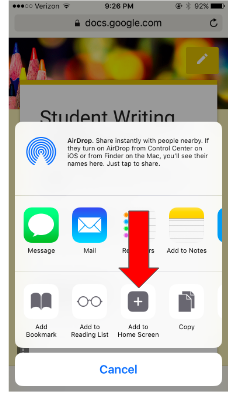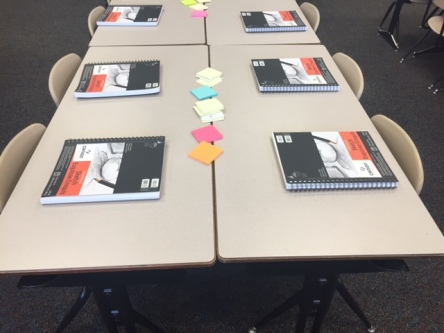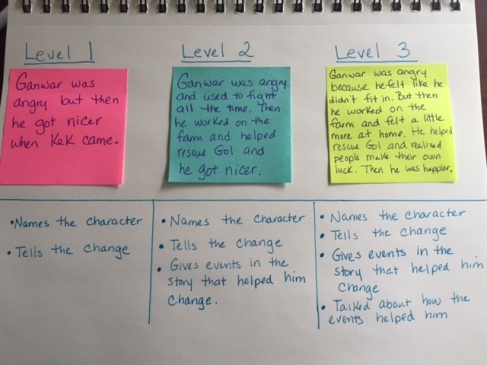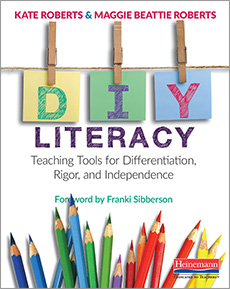
My son Ryan and I recently went to get some frozen yogurt one evening. It never ceases to amaze me how much that boy can put away. I stood in awe as I watched him prepare his dish – chocolate yogurt topped with marshmallow sauce, cotton candy bits, sour gummy worms and kiwi to top it all off. He dug right in, never once considering that all those flavors might not mix well. I watched in disbelief as he finished the entire bowl.
On the way home, Ryan turned to me and said, “My stomach kind of hurts.”
Really???
Sometimes more is NOT better.
The same is true in teaching. Each year, we start off with grand plans for how we will ramp up our workshops to do more, accomplish more, and reach more students. If you’re anything like me, this doesn’t always turn out well. Often I would get overwhelmed and sometimes just give up and default to teaching the same way I always did.
I called this post 7 Ways to Ramp Up Your Student Conferences. But I should have called it Choose 1 of These 7 Ways.. Sometimes, less is more. Any one of these things can help make you more confident as you work on improving your student writing conferences. And as always, the most important thing is to try something, reflect, and revise.

Make a List: Make a list of the things you know students struggle with based on past experience. Do students have trouble coming up with ideas? Do they lack stamina in writing? Do they have trouble organizing their pieces? Do they forget simple grammar and punctuation? Knowing what students may struggle with can help you plan ahead and give you confidence in what direction you could go with your teaching.
Become an Expert Researcher: Your conferences will go much better if you know what you are looking for ahead of time. One way to do this is to read some of the student work before actually meeting with them in a conference. Each day, have a different group of students leave their writing folders or notebooks out before they leave for lunch, or before they go home for the day. Walk around and quickly skim their work. Getting an idea of how their work is progressing will help you when you go to meet with them in a conference. Another great researching tool is to ask teachers from a grade level or two above you to share some of the best writing in each genre. What writing moves are these older students making? Knowing where students will need to go can help you focus instruction for the better writers in your class. Finally, make sure to ask students what they are working on as writers during your conference. If they already have a self-directed focus, you can help them by showing them how to continue to lift the level of work in that area. Allowing them to choose area of focus increases the likelihood that they will work on the skill you are teaching.

Be Prepared with Mentor Texts: If you know where your students will struggle, or have some idea of what you want the students to work on, you can be ready with mentor texts for their conferences. Mentor texts can be writing that you have done, writing other students (names removed) have done, picture books, excerpts from chapter books, articles, etc. The key is to keep in mind the areas that you know you will address often in conferences as you read anything and then to hold onto it. You can use post its to mark the places in the text that you want to show so that it is easily accessible for students. Do you want to show them how a non-fiction text can be organized? Grab your writing notebook and post-it a page where you did that kind of writing. Do you want to show them how a writer uses details? Grab your favorite read aloud and post it the page where a writer showed instead of told. You can color code your post-its to make it easier to find. Blue post-its for organization. Pink post-its for elaboration. Yellow post-its for conventions. You can also write on the post-it what you want to point out on that page. Keep your mentor texts together in a basket so they are easily accessible to you. Having mentor texts available will make the teaching go more smoothly and can really help focus your instruction.
Work on Your Compliments: Recently, our district was lucky enough to have Jerry Maiara come and talk to us about feedback in writing. Jerry worked with the Teachers College Reading and Writing project for years and is now the curriculum director at a private school in New York. Jerry talked about “Compliments 2.0” in our workshop with him. Sometimes, we give vague compliments – “You’re doing a great job!” or simple compliments, “I like how you used paragraphs.” He told of a time when he conferring and when he went to compliment the student, the student rolled his eyes at him. Jerry said that students pick up on the fact that we say the same things over and over, or give each student the same or similar compliment. When we do that, the compliment doesn’t mean much. Jerry encouraged our teachers to kick it up a notch and really notice what the student is doing well. And then not only say “I like how you’re doing that,” but also add why. For example, “I like how you are organizing your thoughts into paragraphs. It really makes it easier for the reader to understand the big ideas of your writing.” Giving compliments like this encourages students to continue the positive writing behaviors.
Teaching Points – Focus on Strengths: I always considered that the compliment and the teaching point were so different. The compliment was supposed to be something they were doing well as writers; the teaching point was something they needed to work on. But then I realized that by focusing on strengths, students feel good about the progress they are making and are more willing to continue the work in that area. Using the example from above, “I like how you are organizing your thoughts into paragraphs for beginning, middle and end. It really makes it easier for the reader to understand how your story will progress.” You can build on that strength by asking the student to take the next step. “Now, can I show you another way that helps your reader understand how dialogue is progressing? You can use paragraphs each time a different character speaks. Let me show you.” Sometimes, the thing that you want them to work on is something they aren’t doing well at all. But everyone has a starting place and is achieving is some way. If a student uses very few periods at the end of sentences, you can still compliment them for the ending punctuation that they are using. “I like how you are starting to use end punctuation in key spots, like you did here and here. It makes it so much easier for the reader to follow your thoughts. Can I show you one more thing that writers do to make sure they are using enough end punctuation for readers? Sometimes writers use Red Alarm words…” Building on a student’s strengths rather than their weaknesses can motivate them to continue working on that area.

Take Notes on Your Conferences: As with anything in our teaching, we have to stop and first ask ourselves, What is the purpose? What will you use the notes for? Will you use them to plan small groups? Will you use them to share at parent teacher conferences? Are they just notes for you to remember what you talked about? Knowing your purpose can help you decide what kind of notes to take. Unfortunately, there is no one right way. What is going to work for you will probably be different than what will work for someone else. It will take some trial and error. Are you a digital note-taker? You may want to experiment with using Evernote, Google Docs or the Confer app. Do you prefer paper notes? You may want to try some version of the formats found here in this Google file. Taking notes on conferences are only helpful if you will use them in some way. Discovering your purpose for note-taking is the first and most important step in this process.
Follow Up: One of the most important things that you can do to improve the effectiveness of your conferencing is to follow up with students. If students know that you are going to be checking on their progress, they will be more accountable for the work. This follow-up does not need to be another conference. You could use the last 5 minutes of workshop, or end of the day time, to have students quickly show you how they implemented the work you talked about. If they weren’t able to implement your teaching point, it could mean that they still don’t understand. A small group conference might be appropriate as a next step. Maybe they didn’t have enough time to do it – you could ask them to show you at the end of the next workshop time. Following up with the 5-6 students you confer with each day can help ensure that the work will get done and that students are continuing to ramp up their writing skills.
Conferring is one of the most effective ways to offer individualized instruction and feedback in your writing workshop. But it can also be the hardest and most intimidating part for teachers, too. Trying all of these steps above would prove overwhelming. But by focusing on one or two of them over the course of a quarter or trimester could make conferring more manageable and successful for you and your students.
Good luck!











































